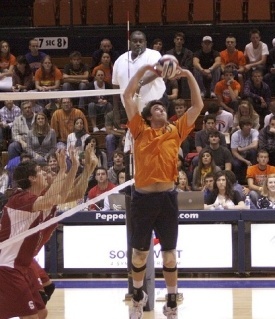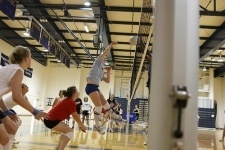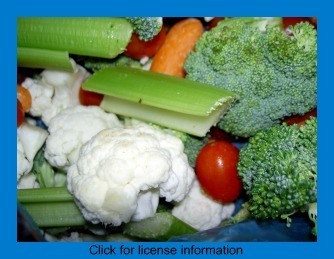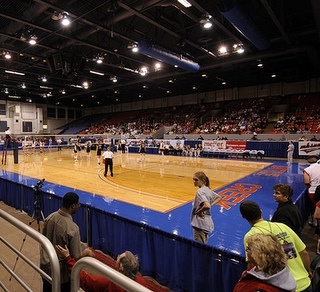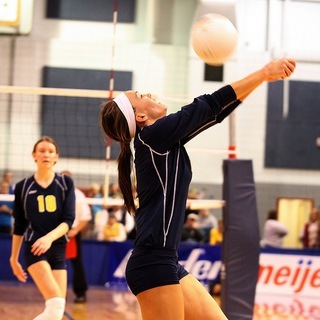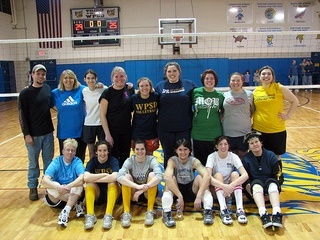If you are looking for sports volleyball training, then this interview with Barry Lovelace will exactly what you are looking for.
For those of you that are unfamiliar with Barry, he is known as the “King of Core.” He is a member of Team Men’s Fitness, has appeared in Men’s Health, is a fitness professional specializing in athletic performance, and has created several athletic training programs (including Training for Volleyball), and is an expert author.
It is a great pleasure for me to bring you this exclusive interview with Barry!
Where did your passion for volleyball develop?
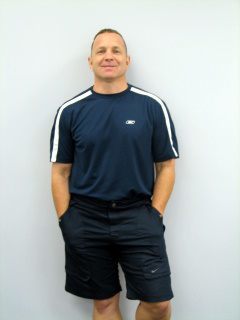 Barry: First, I would like to thank you for taking the time to interview me. It is a great honor and I love your website. It offers a ton of info for all coaches at all levels.
Barry: First, I would like to thank you for taking the time to interview me. It is a great honor and I love your website. It offers a ton of info for all coaches at all levels.
My passion for volleyball started after I trained two volleyball players in April of 2006. They were the first volleyball athletes I trained and like I do with all of my athletes, I try to go and support them and watch them play.
Well, I was extremely impressed by their athleticism. Their quickness, power, and movement were not what I expected. It was awesome and from that time on I have seen hundreds of matches and love every second of it.
The other aspect of volleyball that stuck out like a sore thumb was how the coaches and athletes had so much respect for each other. Being an ex-wrestler and football player it was not very common to walk up to an opponent before a game and hug them and wish them well. This was very different, in a good way. I have so much respect for the volleyball coaches and athletes around the world.
In your opinion, what sets of muscles are the most important for volleyball players?
Barry: Well, this is where my style of training differs from so many others. One thing I have never done with any of my athletes is focus on the “muscles.” You will not find a workout of mine that targets certain muscle groups on Day One, another on Day Two etc.
How I train athletes is based on ‘movement‘ and how we can generate tons of elasticity within that movement. Yes, the elasticity is stored in a muscle, BUT the muscle is not what I focus on. Again, movement is what what I focus on.
I know you are thinking “OK Barry, what exactly is elasticity?” Simply put, it is storing energy so that when needed, you can efficiently release it with very little effort. This is an important part of sports volleyball training. When you need to jump, you will spring with elasticity. When you need to hit, you will with tons of power and very little effort by creating elasticity.
One way we do this is by using flexible resistance such as bands.
Now, don’t get me wrong, we do work the shoulders, legs, hamstrings, core, etc. but in a way that others do not, which is why I feel this style is taking off internationally and is respected by many coaches and athletes as well as my fitness professional friends around the world.
This is how I train a team of volleyball players. I like to call the circuits a ‘buffet of sports performance exercises’. What that means is we have several stations set up on the volleyball court. We set them up by making sure they are not working the same type of movement back to back and incorporate quickness and reaction drills and plyometrics.
For example, we may have an exercise for swing speed and power on station one. Station two may be a body weight plyometric exercise. Station three may be a strict core exercise. Station four a lateral movement exercise with band pull. This will continue for 10-12 stations and each station is approximately 45-60 seconds.
What you will notice in these programs is an ‘interval training’ style, but first let me give the reasons why we do timed stations and why we do not work the same type of movement back to back. This is an important piece of sports volleyball training.
Timed sessions are performed so that we work on muscle and cardiovascular endurance at the same time. Muscle endurance means exactly how it sounds. The goal is not to have ‘strong’ muscles; the goal is to have long lasting and powerful muscles for an entire match. How many times do we see athletes whose shoulders are shrugging, legs wobbling etc. on the court in long matches? Many times that isn’t necessarily their cardiovascular endurance. It is their muscle endurance.
Cardiovascular endurance is basically ‘getting in shape’ and that is why we do interval training. Higher intensity exercise, followed by a low intensity exercise. You will never see my athletes jogging to become a better athlete on the court. That just doesn’t make sense.
One last thing Kevin, because I can go on and on about training. The NUMBER ONE focus is ‘training from the inside out‘. All of my athletes, whether they are Irish Step Dancers, volleyball players, baseball players, basketball players and so on train from the center out. This means using the CORE. The core is a central part of sports volleyball training.
All movement begins in the core and all power is generated from the core. The limbs, arms, and legs are an extension of the core. When coaches and athletes start implementing safe and effective core training to their routine they notice results within days.
Many players are looking to increase their vertical jump. What advice would you have for them?
Barry:Kevin, that is easy. Buy Training for Volleyball! I am only kidding.
Plyometrics and band training as you will see many of my athletes use. Plyometrics is an awesome way to increase vertical, but I have advice on how to get results very quickly by putting a few things together with plyometrics.
An example is perform a plyometric exercise, rest 20 seconds or more if needed, follow that up with a safe squat where your butt does not go below the knees for approximately 20 repetitions, then head to a wall and perform a wall squat where you push your heels through the ground and butt into the wall. The last exercise may only be performed for a few seconds if done correctly. If the athletes and coaches know how to implement the band training with the squats, I cannot recommend that enough.
This is one way that will create tons of elasticity, increase vertical, and spring like a super ball when needed. How is that for sports volleyball training?
What makes Training for Volleyball uniquely targeted for volleyball players?
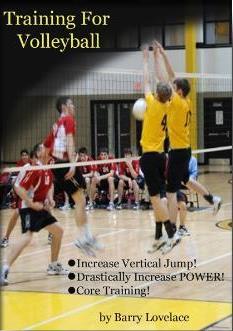 Barry: Not only is Training for Volleyball a great workout you can do anywhere with very little equipment, it also incorporates exercises that resemble movements on the court and focuses on core training as well. The overall concept as mentioned earlier is to drastically improve overall sports performance on the court.
Barry: Not only is Training for Volleyball a great workout you can do anywhere with very little equipment, it also incorporates exercises that resemble movements on the court and focuses on core training as well. The overall concept as mentioned earlier is to drastically improve overall sports performance on the court.
We incorporate hitting exercises with resistance, lateral movements with flexible resistance, footwork, vertical jump exercises all in an effort to become the best volleyball player on the team or court.
Training for Volleyball is the exact same workouts used by the girl who increased vertical five inches after five sessions. She trained all summer and went on to play D2 College where as a FRESHMAN she led her team in overall blocks, and was the starting middle blocker at only 5’7″. She was great at sports volleyball training.
Teams are incorporating the exercises and workouts as well. Training for Volleyball comes with workout suggestions for the individual as well as a team.
What can coaches expect from Volleyball Team Training?
Barry: Volleyball Team Training is a two-hour live clinic in which coaches from all over attended to see first hand how they can train a team on the court, in season or not, and not take up too much of their precious practice time.
I go over every exercise in the program, show several progressions, answer questions and you will also see athletes and coaches doing the workouts. I was stunned when I said, “OK, who is ready to workout?” and a bunch of the coaches hopped on board. You will get to see all of this.
The best thing that we implemented in Volleyball Team Training is the Coaching Cards. The coaching cards make a coaches life extremely easy when it comes to planning the training. The number one reason I came up with them is because I see so many coaches who stop training in season because planning a session is too much work.
The cards are color coded by exercise type. This includes power, vertical, endurance, quickness, and reaction. Each card has two to three pictures on them showing the exercise in progression as well as which equipment to use, what circuit it came from in Volleyball Team Training and a code in the top right corner.
All the coach has to do is grab the cards, hand them to an assistant or captain and ask them to set up the training on the court. The cards stay at the station so that the athletes can see what to do in case they forgot. This makes sports volleyball training even easier.
The program comes with three circuits already prepared for the coaches on the Coaching Card Training log you also get. The color code enables the coaches to make up their own workouts as well. I give suggestions on how to set them up. The training log is where the coaches log the date and code used at each station. Why is this a good thing? Well, during the season things get hectic, coaches have little time to prepare and they can’t do everything themselves.
So if they are running late or forgot to prepare, no worries. With the coaching cards they simply go to the log, pick out a workout they did a few weeks ago or whenever and quickly grab the cards by code and have that session planned in a few seconds. All they have to do is hand off to the captain or assistant coach who sees what equipment they need and set up the circuit.
Volleyball Team Training has been used by national and state champions and all of these teams have one thing in common other than using the workouts and that is they keep training in season. It can be done and that is the number one reason I put this program together. It is the pinnacle of sports volleyball training for a team.
It doesn’t make much sense to train like crazy off-season then not do any type of training in season when that is the time you need it. That is my opinion anyway.
What advice would you have for a player that wants to make the team next year?
Barry: Good question. From a training standpoint I am asked this question often and I cannot recommend core training and interval training enough. I will often go onto Yahoo Answers and young players ask this question and many will respond, ‘lift weights and jog’. If you really want to change your athletic ability and impress the coaches, create tons of core power and be the one who isn’t dying for air after two minutes of warming up.
Core training will create tons of power in your serve, hitting, and also help in reaction time. Interval training will drastically improve endurance on the court so that when the time comes the athlete will be in awesome shape and be the one who stands out on the court.
This awesome interview on sports volleyball training has tons of practical information for players and coaches alike. I highly recommend that you check out Barry’s program Training for Volleyball. It is THE program that will make a difference for you on the court.
I would also like to thank Barry for taking time out of his busy schedule to do this interview.

